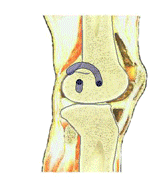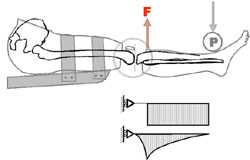|

|
ROTATION AND SLIDING
The instantaneous centre of rotation imposes a characteristic movement to the dynamics of bending and stretching
of the knee:
- in the first 30° the femur rotates on the tibia
- from 30° on the rotation is combined with a sliding which
becomes more and more progressive. The knee has a rotational-translatory motion.
The apparatuses which assist the knee in its bending and stretching must have the same movement. |
BIO-MECHANIC ANALYSIS OF THE KNEE DURING LEG EXTENSION
In mechanics it is possible to compare the condyle femoral surfaces to a sliding vertical plane. The flat tibial surface, on the other hand, can be imagined as a trolley that can slide freely on the vertical plane, held by the cruciate ligaments and in particular by the anterior cruciate ligament.
The weight (P) opposes the force expressed by the femoral quadriceps (F) which is applied at the point of insertion of the patellar tendon on the tibial eminence situated a few centimetres from the tibial articular surface.

Dynamics
During exercise, the kinetic energy of the mobile arm, when it gets to the upper dead point, transforms into potential energy as soon as the arm inverts its movement.
The kinetic energy of the leg, on the other hand, tends to make the motion continue to the body segment upwards (hyper-tension); a “horizontal pivoting” is thus created, since lifting the foot lowers the head of the tibia since the fulcrum becomes the point of tibial insertion of the quadriceps, which, when the contraction has finished, can no longer change its position in the space. The pivoting in this case creates a strong traction on the posterior cruciate ligaments (PCL).
When the movement changes direction, the mechanical arm offloads the potential energy onto the leg, while the latter is still in hyper-tension. This overload changes the direction of the “pivoting”, or rather it lowers the distal part of the leg and raises the head of the tibia, putting tension on the anterior cruciate ligament (ACL) while the fulcrum keeps the insertion
of the patellar tendon tense by contracting the quadriceps which is decisive for control of the movement.

So that the abnormal stress produced by the “pivoting” is not offloaded onto the articular structures but on the mechanical organs, the whole lower arc must be anchored to the machine.

|
ANCHORING THE LEG
The leg cannot be anchored unless the mobile load arm turns on a fixed centre which, being the ‘strongest', imposes its trajectory.
|
|
|
If the leg is anchored while stretched out, it will become distanced from its base during bending, causing severe distress to the ligaments. |
If the leg is anchored during bending, a strong compression between the articular heads will be created during stretching. causing severe distress to the cartilages and the meniscus. |
|
THE KNEE TOP JOINT SYSTEM
It accompanies the knee perfectly during its trajectory combining rotational and translatory motion.
Every point of the mechanical arm remains in perfect contact with the leg throughout all its movements, and does not transmit abnormal tensions to the weak structures of the knee. |
|
|